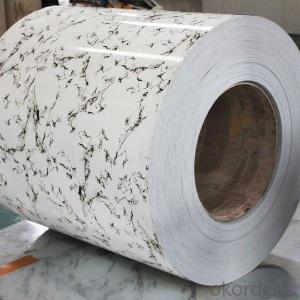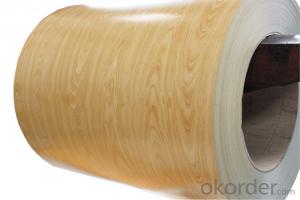Prepainted Galvalume Rolled Coil for Roof
- Loading Port:
- Shanghai
- Payment Terms:
- TT OR LC
- Min Order Qty:
- 25 m.t.
- Supply Capability:
- 30000 m.t./month
OKorder Service Pledge
OKorder Financial Service
You Might Also Like
Structure of Prepainted Galvalume Rolled Coil

Description of Prepainted Galvalume Rolled Coil
Aluminum zinc coils is a kind of coated steel coil/sheet. With the cold rolled steel of different strength and thickness as substrate, it is produced through applying Al-Zn coat on both faces by hot dip process. In its coating, Al accounts for about 55%, Si 1.6%, while the remaining is Zn. Aluminum zinc coils enjoys both the physical protective feature and durability of Al and the electrochemical protective property of Zn. And its surface has bright silver color and regular embossed-like figure, which are highly decorative.
Main Feature of Prepainted Galvalume Rolled Coil
1.Corrosion resistance: It mainly depends on the aluminum protection. When the zinc being worn, the aluminum will form a dense layer of aluminum oxide, resist corrosion material to prevent further corrosion inside.
2. Heat resistance: Aluminum zinc alloy steel sheet has excellent heat resistance, can withstand high temperatures over 300 centigrade, and is similar with aluminized steel high temperature oxidation resistance. It often used in chimney pipes, ovens, fluorescent lighting device and the device cover.
3. Heat reflective: Galvanized steel plate heat-reflective high rate is twice as galvanized steel, often used to make insulation materials.
4. Economy: Because density of 55% AL-Zn is smaller than the density of Zn, so in the same weight and thickness of Galvanized zinc layer, aluminum-zinc steel plate is larger area more than 3% of galvanized steel sheet.
Applications of Prepainted Galvalume Rolled Coil
1. Construction and building: roofing; ventilating duct; handrail; partition panel;etc.
2. Electric appliance: refrigerator; washing machine; refrigerator; DVD;etc.
3.Transportation: oil tank; road sign; etc.
4.Agriculture:barn; etc.
5.Others:vending machine; game machine; etc.
Prepainted Prepainted Galvalume Rolled Coil Image

Specifications of Prepainted Galvalume Rolled Coil
Structure | |||
Item | Thickness | Type | Feature |
Laminated film | 50μm | Polyethylene | Protecting from scratchs and contamination(option) |
Top coat | 20μm | Polyester Fluorine | Chemical resistance and formability |
Primer coat | 5μm | Polyester | Workability, corrosion resistance and adhesion to the primer coating |
Chemical treatment | 1μm | Chromate | Good adhesion and corrosion resistance |
Substrate | 0.2mm-1.2mm | GI.GL,AL | GI.GL,AL |
Back coat | 5±2μm | Epoxy | Corrosion resistance and adhesion to the substrate |
FAQ of Prepainted Aluminum Zinc Rolled Coil for Construction
We have organized several common questions for our clients,may help you sincerely:
1. What is the minimum order quantity ?
Our MOQ is 50mt for each size. And we will consider to give more discount if you make big order like 1000 tons and more. Further more, the more appropriate payment term your offer the better price we can provide.
2. How long can we receive the product after purchase?
Usually within thirty working days after receiving buyer’s advance payment or LC. We will arrange the factory manufacturing as soon as possible. The cargo readiness usually takes 15-25 days, but the shipment will depend on the vessel situation.
3. How to guarantee the quality of the products?
We have established the international advanced quality management system,every link from raw material to final product we have strict quality test;We resolutely put an end to unqualified products flowing into the market. At the same time, we will provide necessary follow-up service assurance.
- Q:How are steel coils inspected for surface cleanliness during processing?
- Steel coils are inspected for surface cleanliness during processing through various methods such as visual inspection, magnetic particle inspection, and ultrasonic testing. These methods help identify any contaminants, defects, or surface irregularities that may affect the quality of the steel coils.
- Q:So I'm trying to decide which is better. I've always had aluminum on my 6 yr old tb gelding as I do hunters on him. He's never had steel on but I've recently moved and the shoer here is more expensive. So is aluminum really worth the extra cash to keep him light on his feet or is steel really not that much different?
- IMO, steel is fine. The only time I've felt that aluminum was important was: 1. A horse with a specific shoeing issue that required an aluminum shoe. 2. A racehorse-- every micro-gram counts. 3. Top level pleasure horses who need a little bit flatter knee. Everything else I've seen did just fine in regular steel shoes.
- Q:What are the common methods of packaging steel coils for transportation?
- There are several common methods of packaging steel coils for transportation. One widely used method is to use steel strapping or bands to secure the coils together. This method involves tightly wrapping the coils with steel bands and securing them with metal buckles or seals. The strapping helps to keep the coils in place and prevents them from shifting or rolling during transportation. Another common method is to use wooden pallets or skids to stack and transport the steel coils. The coils are placed on the pallets and secured with steel strapping or bands. This method provides stability and allows for easy handling and loading onto trucks or other transportation vehicles. Some steel coils are also packaged in wooden crates or boxes. These crates are typically made of strong and durable wood and are designed to protect the coils from external impacts or damage during transportation. The crates are often reinforced with steel bands or strapping to provide additional strength and stability. In addition to these methods, some steel coils are packaged in specialized containers or units. These containers are specifically designed to hold and secure steel coils for transportation. They often have built-in mechanisms or features that make loading and unloading the coils easier and safer. It is important to note that the specific method of packaging steel coils for transportation may vary depending on factors such as the size and weight of the coils, the mode of transportation, and any specific requirements or regulations in place.
- Q:What are the different methods of engraving steel coils?
- There are several methods of engraving steel coils, including laser engraving, chemical etching, mechanical engraving, and electrochemical etching. Each method involves different techniques and tools to create precise and permanent markings on the surface of the steel coils.
- Q:What are the common challenges in steel coil manufacturing?
- Some common challenges in steel coil manufacturing include maintaining consistent quality, managing the weight and size of coils, ensuring proper surface finish, minimizing defects such as dents or scratches, preventing coil damage during handling or transportation, and optimizing production efficiency to meet customer demands.
- Q:What is the process for uncoiling and recoiling steel coils?
- To ensure the safe and efficient handling of steel coils, several steps are involved in the process of uncoiling and recoiling. Firstly, the steel coils are transported to the desired location using cranes or forklifts and carefully unloaded from the transportation vehicle. They are then placed in a designated area. Before uncoiling, it is crucial to inspect the steel coils for any damage or defects. This step ensures that only quality coils are further processed. Once inspected, the steel coils are secured to prevent any movement during the uncoiling process. Clamps or straps are used to hold the coils firmly in place. Uncoiling involves gradually unwinding the steel coil, which can be done manually or using specialized machinery such as uncoilers or decoilers. The coil is typically fed through a series of rollers that guide the unwinding process. In some cases, the steel coil may need to be straightened before further processing. Straightening machines apply pressure to remove any bends or twists in the steel. If necessary, the uncoiled steel coil may be cut into smaller sections or sheets using shearing machines or other cutting tools. The dimensions and size of the cuts depend on the specific project requirements. Once the desired processing steps are completed, the steel coil can be recoiled. This involves rewinding the steel into a new coil shape, which can be done manually or using recoilers. Recoilers wind the steel evenly and tightly to maintain its integrity. After recoiling, the steel coils are typically packaged and stored for further transportation or use. They may be wrapped in protective materials such as plastic or metal sheets to prevent corrosion or damage. In conclusion, the process of uncoiling and recoiling steel coils requires careful handling, inspection, and the use of specialized machinery. By following these steps, steel coils can be efficiently processed and prepared for various applications in industries such as construction, automotive, and manufacturing.
- Q:i have recently gotten into DIY and am planning on making my own knife. My question is what kind of steel would be good to use for heat treating if i plan on using water and not oil in the process.
- Go to junkyard get old leaf spring, cut out knife, start sharpening. Why waste time heat treating steel when the spring steel as already be done.
- Q:What are the common manufacturing defects in steel coils?
- Common manufacturing defects in steel coils include surface defects such as scratches, pits, and dents, as well as internal defects like inclusions, cracks, and voids. Other common defects can include uneven thickness, waviness, and coil set.
- Q:How are steel coils straightened?
- Steel coils are straightened using a process called leveling, which involves passing the coil through a series of rollers that apply pressure to gradually remove any bends or deformations in the steel.
- Q:why do you need to heat steel when hardening, molecules etc etc
- Metalurgy is a fascinating science which has been used to mark the ages of civilization: the Bronze Age, the Iron Age, etc. Ancient sword makers heated steel until the polished surface showed a straw color (which we now know to be about 550°F, and due to surface oxides) and then plunged the blade into a tank of water. The blade was quickly removed, repolished, and observed closely for heat transfer from the core returning the surface to straw color. If so, it was quenched again. This technique left the surface hard without making the blade brittle. Today the steel crystal lattice is known to be either face centered cubic (iron atoms at the corners of a cube and iron atoms centered in the faces of the cube) or body centered cubic ( iron atoms at the corners of the cube and an iron atom at the geometric center of the cube). Most experienced machinists can estimate the temperature of steel from the color of its surface oxides.
1. Manufacturer Overview |
|
|---|---|
| Location | |
| Year Established | |
| Annual Output Value | |
| Main Markets | |
| Company Certifications | |
2. Manufacturer Certificates |
|
|---|---|
| a) Certification Name | |
| Range | |
| Reference | |
| Validity Period | |
3. Manufacturer Capability |
|
|---|---|
| a)Trade Capacity | |
| Nearest Port | |
| Export Percentage | |
| No.of Employees in Trade Department | |
| Language Spoken: | |
| b)Factory Information | |
| Factory Size: | |
| No. of Production Lines | |
| Contract Manufacturing | |
| Product Price Range | |
Send your message to us
Prepainted Galvalume Rolled Coil for Roof
- Loading Port:
- Shanghai
- Payment Terms:
- TT OR LC
- Min Order Qty:
- 25 m.t.
- Supply Capability:
- 30000 m.t./month
OKorder Service Pledge
OKorder Financial Service
Similar products
New products
Hot products
Related keywords





























